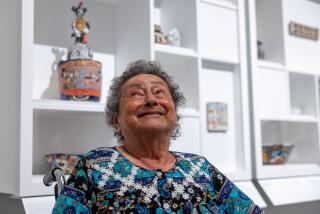Haunting Works From Cuban Exile Mendieta
In 1985, Cuban-born artist Ana Mendieta died young and violently in New York at age 36. Now a sampling of her work is on view at the Museum of Contemporary Art in an installation organized by assistant curator Alma Ruiz and titled “Ana Mendieta: Siluetas.”
Mendieta’s beginnings were not easy. Born in Havana in 1948, she escaped the revolution at 13 during the so-called Peter Pan flights that brought Cuban children to the U.S. Here she was raised in a series of orphanages and foster homes. Arguably better than life in Castro’s Cuba, the displacement eventually made her into an artist preoccupied with finding deep, lost roots.
Her pieces seem both distant and haunting. Distant, partly because she was mainly a body and earthworks artist. Her ephemeral constructions can only be known from photographs and videotapes such as those on view. They also, however, stand at a remove because--as an artist--she lived in a primal past. Her imagery looks like something made before Altamira or Lascaux, when early humans gouged images of themselves on cave walls. Crude, they were nevertheless powerfully telling. After all, they were the atavistic formulation of the same profound questions we still ask ourselves--especially those concerning sex and death.
Mendieta’s “Siluetas” (Silhouettes) were made in Iowa and Mexico mainly during the ‘70s. Only one of the dozen photos is sensually sexual. It depicts the artist lying naked on a stony hillside covered with delicate flowers that seem to blossom from her flesh. Other images concentrate on the funereal. “Incantation at Olokun-Yemayan, Iowa” tracks the impression of her body on the ground surrounded by a huge, suggested hand-of-God outline with soil. It’s reverent but seems to wonder if our deities are really made of the same stuff as ourselves.
Obsessed and repetitive in theme, Mendieta’s work nonetheless unfolds progressive layers of meaning. We note, for example, her attraction to ancient pre-Columbian sites such as Mexico’s Monte Alban, suggesting a desire to merge with her ancestors. “Bamboo and Gunpowder”--related to one of the videotapes on view--shows a silhouette illuminated and consumed by fire in a ritual act of sacrifice.
Her “Rupestrian” sculpture series of 1981 includes a half-dozen large photoprints. The title refers to living among rocks. Mendieta virtually fuses with them in images done on the walls of a cave in the woods of Jaruco, near Havana. The work is more confident and ferocious than “Siluetas.” Here she virtually becomes the archetype of the ancient fertility goddess. Her imagery is at once rougher and more economical. “Atabey (Mother of the Waters)” impressively expresses legs folded against the body in a single shape. “Guanaroca (First Woman)” reads almost like a glyph of a female reduced--or expanded--to a creature who is all vulva.
Mendieta’s work will, I think, haunt even those viewers who don’t know the rest of her story. It’s all the more poignant for those who do. In 1985, she died in a fall from the 34th story of the New York studio she shared with her husband, Minimalist sculptor Carl Andre. Just prior to her death, neighbors heard the couple arguing violently. Andre was charged with her murder. In 1988, he was acquitted.
* Museum of Contemporary Art at California Plaza, 250 S. Grand Ave., through April 12, closed Mondays, (213) 626-6222.
More to Read
The biggest entertainment stories
Get our big stories about Hollywood, film, television, music, arts, culture and more right in your inbox as soon as they publish.
You may occasionally receive promotional content from the Los Angeles Times.










